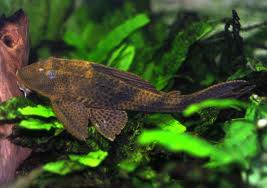
Common name: Common Pleco, Trinidad Plecostomus
Scientific name: Hypostomus Plecostomus
Average Adult Fish Size: 1 – 2 feet / 30-60 cm
Place of Origin: Central and South America
Typical Tank setup: S. American biotope with rocks, caves, driftwood/bogwood, and sturdy, well-rooted plants.
Recommended Minimum Aquarium Capacity: 10 gallon / 40 litre when small, 50 – 100 gallon / 200 – 400 litre when large.
Compatibility: A lot of different fish species can be housed together with common pleco, but fat or flat bodied fish – such as goldfish and discus – should be avoided since plecos can be fond of sucking on such fishes.
Temperature: 68 – 82 Degrees F / 20 – 28 Degrees C
Water chemistry: pH 6.4 – 7.7
Feeding: Feed a varied diet of algae wafers, spirulina based flakes and pellets along with frozen brine shrimp. Vegetables such as lettuce, cucumbers, spinach leaves, and green beans are appreciated. Larger specimens will also readily eat market shrimp and fish fillets. They like to gnaw on wood, so keeping driftwood/bogwood in the aquarium is important.
Sexing: Sexing the common pleco is tricky, but in some species the males tend to be smaller than the females and develop bigger barbells. Some sources claim that the chin barbells are somewhat smoother in females.
Breeding: Breeding the common pleco in captivity is hard and only a small number of aquarists have managed to successfully raise common pleco fry in their aquariums. An aquarium of 800 litre / 200 gallon, or more capacity with plenty of suitable hiding spots is recommended if you want to try breeding the common pleco. In the wild, this plecostomus prefers to use caves along the river bank as spawning sites and such conditions are hard to duplicate in an aquarium. When common plecos are bred in captivity for the aquarium hobby, they are normally bred in ponds, not in aquariums.
Make sure that you plecos are happy and healthy in the aquarium and keep them on a nutritious and varied diet. It is also important that you provide them with optimal conditions when it comes to water quality. If you are lucky, your couple will get into spawning mood and the male will attract the female to a cave. The female will deposit the eggs and the male will stay around after fertilization to care for the offspring. He will also chase away predators. After 4-8 days the eggs will hatch and the fry will be free swimming within another 4-6 days.
Additional Information: They will eat plants if not well fed. A well cared for plecostomus can live for 20 years or longer! It is important to keep the aquarium covered because they jump! In the wild, plecos use this ability to escape to better conditions during dry periods. They can’t really travel on land, but they are strong enough to wiggle their way from a shallow puddle to a deeper puddle in a drying riverbed. To a certain extent, they are capable of absorbing oxygen directly from the air so they will last longer on land than many other fish. If you come home and find your pleco seemingly unconscious on the floor, you should put it back in the aquarium because it might not be dead yet. Do not let the water go all the way up to the lid, because the common pleco likes to be able to swim up to the surface and gulp air. The fish uses the air to control its buoyancy.
The common plecostomus produces a lot of waste. Regularly vacuum up the feces and change 30-50% of the water at least on a weekly basis. If you allow the water quality in the aquarium to drop too much, it can make the pleco think that the dry season has started and that its home is about to dry out. In order to save itself, it might try to escape by jumping out of the aquarium. A desperate pleco can bash itself against the aquarium lid until it sustains severe injury or dies.


Related Posts
Croaking Gourami – Trichopsis vittatus
Benthochromis Tricoti
Large-eyed Mouthbrooder – Callochromis Macrops